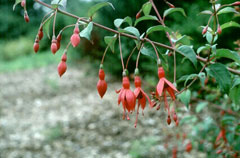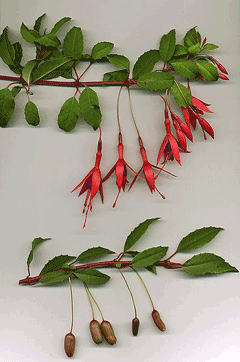 |
|
(c) 2010 Ken Fern & Plants For A Future |
 |
| biolib.de |
Translate this page:
Summary
Bloom Color: Red. Main Bloom Time: Late summer, Mid summer. Form: Irregular or sprawling, Rounded.
Physical Characteristics

 Fuchsia_magellanica is a deciduous Shrub growing to 3.6 m (11ft) by 2 m (6ft) at a medium rate.
Fuchsia_magellanica is a deciduous Shrub growing to 3.6 m (11ft) by 2 m (6ft) at a medium rate.
See above for USDA hardiness. It is hardy to UK zone 6 and is not frost tender. It is in flower from July to October. The species is hermaphrodite (has both male and female organs) and is pollinated by Insects.
It is noted for attracting wildlife.
Suitable for: light (sandy), medium (loamy) and heavy (clay) soils, prefers well-drained soil and can grow in heavy clay soil. Suitable pH: mildly acid, neutral and basic (mildly alkaline) soils. It can grow in semi-shade (light woodland) or no shade. It prefers moist soil. The plant can tolerate maritime exposure.
UK Hardiness Map
US Hardiness Map
Synonyms
F. gracilis. F. macrostemma. F. riccartonii.
Plant Habitats
Edible Uses
Fruit - raw. A juicy berry[K], it is not very palatable[105, 177].
References More on Edible Uses
Medicinal Uses
Plants For A Future can not take any responsibility for any adverse effects from the use of plants. Always seek advice from a professional before using a plant medicinally.
Diuretic, febrifuge[46].
References More on Medicinal Uses
The Bookshop: Edible Plant Books
Our Latest books on Perennial Plants For Food Forests and Permaculture Gardens in paperback or digital formats.

Edible Tropical Plants
Food Forest Plants for Hotter Conditions: 250+ Plants For Tropical Food Forests & Permaculture Gardens.
More

Edible Temperate Plants
Plants for Your Food Forest: 500 Plants for Temperate Food Forests & Permaculture Gardens.
More

More Books
PFAF have eight books available in paperback and digital formats. Browse the shop for more information.
Shop Now
Other Uses
A black dye is obtained from the wood[46, 61]. Very resistant of maritime exposure and tolerant of trimming it makes a good informal hedge in mild maritime areas[29, 75, 166]. The variety 'Riccartonii' is commonly used[200]. The cultivar 'Prostrata' forms a carpet of growth and can be used as a ground cover when planted about 60cm apart each way[208].
Special Uses
References More on Other Uses
Cultivation details
Landscape Uses:Border, Container, Ground cover, Specimen. Succeeds in any fertile well-drained circum-neutral soil, preferring one that is rich in humus[1, 200]. Grows well in heavy clay soils. Prefers cool moist conditions and some shade[1, 15]. Succeeds in a good loam if leafmold and sand are added[1]. This species is very resistant to maritime exposure, it can be grown right on the coast[75, 166]. The top growth is hardy to about -10°c[184], this can be cut right back to the ground in severe winters but the plants usually recover well, growing away quickly in the late spring and flowering by late summer[200]. The young growth in spring, even on mature plants, is frost-tender and so it is best to grow the plants in a position sheltered from the early morning sun[K]. The sub-species F. magellanica myrtifolia often bears a very large crop of fruit[K]. The cultivar 'Ricartonii' can be hardy fairly well north in Britain. A lovely specimen 3 metres tall was seen growing in dappled shade of trees in the Monastery Gardens in York[K]. A very ornamental plant, it is a parent of most of the hardy ornamental fuchsia varieties[1]. Plants seem to be immune to the predations of rabbits[233]. Plants are pollinated by humming birds in the wild, they are good bee plants in Britain[108]. Special Features:
Extended bloom season in Zones 9A and above, Blooms are very showy.
References Carbon Farming Information and Carbon Sequestration Information
Temperature Converter
Type a value in the Celsius field to convert the value to Fahrenheit:
Fahrenheit:
The PFAF Bookshop
Plants For A Future have a number of books available in paperback and digital form. Book titles include Edible Plants, Edible Perennials, Edible Trees,Edible Shrubs, Woodland Gardening, and Temperate Food Forest Plants. Our new book is Food Forest Plants For Hotter Conditions (Tropical and Sub-Tropical).
Shop Now
Plant Propagation
Seed - best sown as soon as it is ripe[200] though it can also be sown in the spring[1]. Surface sow the seed in pots in a warm greenhouse and do not allow the compost to dry out[200]. Germination should take place in less than 6 weeks. Prick out the seedlings into individual pots when they are large enough to handle, and grow them on in the greenhouse for at least their first winter. Plant out in late spring or early summer, after the last expected frosts. Inter-nodal cuttings of greenwood, 5 - 8cm long, May/June in a frame. Quick and easy, a high percentage take[78, K]. Overwinter in the greenhouse for the first year and plant out after the last expected frosts. Inter-nodal cuttings of half-ripe wood, July/August in a frame. Very quick and easy, treat as greenwood cuttings above[K]. Cuttings usually succeed at any time during the growing season[K].
Other Names
If available other names are mentioned here
Native Range
SOUTHERN AMERICA: Argentina (Chubut, Neuquén, Río Negro, Santa Cruz, Tierra del Fuego), Chile
Weed Potential
Right plant wrong place. We are currently updating this section.
Please note that a plant may be invasive in one area but may not in your area so it's worth checking.
Conservation Status
IUCN Red List of Threatened Plants Status :

Growth: S = slow M = medium F = fast. Soil: L = light (sandy) M = medium H = heavy (clay). pH: A = acid N = neutral B = basic (alkaline). Shade: F = full shade S = semi-shade N = no shade. Moisture: D = dry M = Moist We = wet Wa = water.
Now available:
Food Forest Plants for Mediterranean Conditions
350+ Perennial Plants For Mediterranean and Drier Food Forests and Permaculture Gardens.
[Paperback and eBook]
This is the third in Plants For A Future's series of plant guides for food forests tailored to
specific climate zones. Following volumes on temperate and tropical ecosystems, this book focuses
on species suited to Mediterranean conditions—regions with hot, dry summers and cool, wet winters,
often facing the added challenge of climate change.
Read More
Expert comment
Author
Lam.
Botanical References
1169200
Links / References
For a list of references used on this page please go here
Readers comment
© 2010, Plants For A Future. Plants For A Future is a charitable company limited by guarantee, registered in England and Wales. Charity No. 1057719, Company No. 3204567.